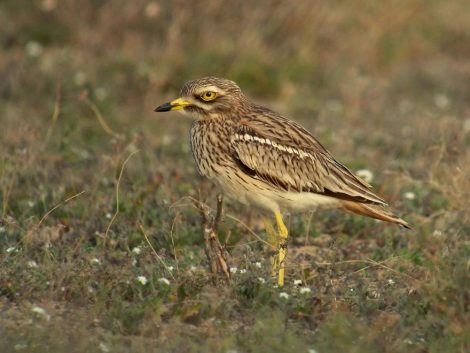Meeting with Eddie Farcy-Jirot, ecologist at the Direction des Routes d’Ile-de-France (DiRIF)
The Eurasian stone-curlew is a bird with large yellow eyes and a shrill cry. This migratory bird is a protected species in Europe. It is on the global and European red lists of threatened species. The Ile-de-France Roads Directorate and ECT have been working together for several years to establish a sanctuary compensation area for this bird. By creating a favourable environment for the bird to establish itself. Where? On the ECT site for the recovery of excavated soil in Villeneuve sous Dammartin (77).
What background is there to the creation of a compensation area for the Eurasian stone-curlew at an ECT site in Villeneuve-sous-Dammartin?
As part of the work to build the Roissy East bypass, which is an extension of the Francilienne and should provide the airport with new access, particularly in the context of the 2024 Olympic Games, the ecological inventory revealed the presence of Eurasian stone-curlew birds. At the roadworks site, it was not possible to preserve all of the areas suitable for the Eurasian stone-curlew, so it was important to create a new area suitable for this species.
This bird likes thermophilic environments. That is to say, dry, rocky environments, rather exposed to the sun and therefore warm. It is a crepuscular and nocturnal bird. We don’t see it much, but we can easily recognize it by its cry. It is a migratory bird and is a protected species at a European level. It has the particularity of nesting in the crevices of the ground. This makes the eggs and chicks very vulnerable. It has almost disappeared from Germany and the Netherlands. There is therefore a strong heritage interest in protecting the species. Indeed, the Plaine de France now appears to be the most northerly population boundary of the Eurasian stone-curlew in Europe.
Why did it choose the Villeneuve-sous-Dammartin site?
An ecological compensation area recreates a space favourable to the species. With the Aliséa design office, we sought to recreate an ecologically equivalent environment. This is why the ECT site in Villeneuve-sous-Dammartin seemed perfectly suited. It is located close to the original habitat. It allows the reproduction of a thermophilic environment. ECT was very sensitive to the issues at stake for the bird. The company agreed very quickly to dedicate 2 hectares. And it has created a favourable environment: a large, sunny, stony, sloping area, which can attract the Eurasian stone-curlew.
In order to create and perpetuate this ecological compensation site, an agreement was drawn up between the State and ECT. This agreement describes the ecological and environmental commitments linked to the compensation and establishes a 2-hectare sanctuary area for thirty years.
What did the annual monitoring of the area reveal?
The regulations governing this compensation area provide for annual monitoring. In 2020 and 2021, monitoring was carried out in summer, at dusk and night, and concluded that the stone-curlew was present, but in an area close to the one directly dedicated to it. The idea was to make the compensation area more attractive. The planned site was probably too exposed to predators.
The ECT teams have done a remarkable job and modified the site. It now has a profile that more closely resembles the bird’s original environment: an embankment of earth and rubble. Interestingly, three different areas have been remodelled by ECT, with varying degrees of exposure. In this way, ecologists will be able to observe the bird’s behaviour in this mosaic of environments. Ecological engineering is not an exact science. It is rather a science of hypotheses. Such a device will allow us to learn more about the bird.
And what do we hope for next?
All the teams hope that the stone-curlew will be attracted by the new facilities. And that we will be able to observe the bird during the next annual monitoring directly on the compensation area. The creation of sanctuary areas for an endangered species is in the interest of biodiversity in general. This is because these areas also become home to a cohort of other species, some of which are also in danger. Therefore, the efforts made for the Eurasian stone-curlew at Villeneuve-sous-Dammartin are also favourable for protected species that are fond of the same type of environment, such as the Oedipoda caerulescens, a blue-winged cricket, or the Little-ringed plovert, a bird that has already been sighted on the site.
Note: Eurasian stone-curlew is listed in Annex I of the 1979 EU Birds Directive. The 74 species classified in Annex I benefit from special protection measures for their habitats, which will therefore be classified as Special Protection Areas (SPA). These are endangered species, species vulnerable to certain changes in their habitat, species considered rare (low population or restricted local distribution), and species requiring special attention because of the specificity of their habitat, as well as migratory species that come regularly.

